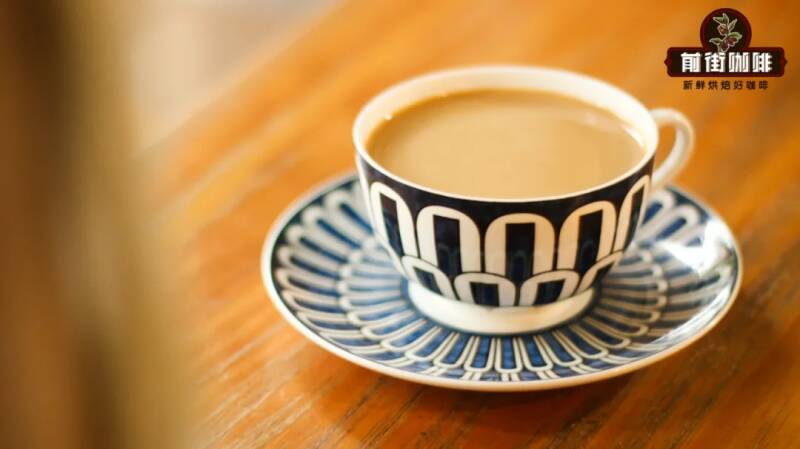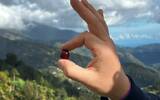What should I pay attention to when adding milk by hand? Can milk coffee be made with drip coffee? How to get high-strength coffee?
When it comes to hand brewing and milk, I believe that the first thing that comes to mind is Oulei coffee. However, due to the low concentration of coffee used in Ole Coffee, it will dilute a lot of taste and taste, so compared with the Italian coffee latte, there is a big difference.

But recently, when Qianjie was surfing the Internet, I saw a shop visit video of a well-known Korean coffee blogger, in which the champion barista made a cup of "latte" with good flavor and taste by making coffee by hand. So how did he do it? Today in front of the street, let's share how to make a latte which is infinitely close to a latte by hand. Are you ready?!
How to make a latte with your hands? Why is this latte in double quotation marks? There are two reasons, the first is that our latte today only refers to the milk coffee made with Italian concentrate as the base and a certain proportion of milk; the second reason is that the milk coffee made by hand can only be approachable and can not completely reproduce the taste and taste of the real latte, and it is quite different from the traditional Ole coffee, so the "latte" made by hand in this article will always have double quotation marks.

Back to the point, how do we use hand-brewed coffee to make lattes? It sounds like an outrageous thing, but it is very easy to do (though it is! ). We only need to focus on the extraction principle of espresso to make a cup of highly concentrated hand-brewed coffee as the base, and then add the right proportion of milk to make a latte! Therefore, our requirement for this hand-brewed coffee is: high concentration. In order to achieve a high concentration of a cup of hand-brewed coffee, we need to adjust the proportion of powder and water in the extraction scheme! Because for the production of a cup of coffee, the less water used for extraction, the more coffee substances will be carried in the water with the same extraction rate, and the concentration will therefore be higher.
However, we need to know that the ratio of powder to water is closely related to other extraction parameters in the same extraction scheme! The increase of the ratio of powder to water means that less water can be extracted from coffee powder, and the overall extraction time will be shortened when other parameters remain the same. Therefore, if you only change the powder-to-water ratio and use the original parameters in other places, you will definitely get a cup of hand-brewed coffee with insufficient extraction and concentration. Take the extraction of espresso, for example, although the powder-to-liquid ratio of espresso is as high as 1:2, it uses a higher water temperature, finer grinding, and is assisted by pressure. this allows a small amount of hot water to extract a high enough concentration of coffee in a short time. Therefore, if we need to use a high powder-to-water ratio to get a cup of hand-brewed coffee with the same concentration as concentrated, we also need to adhere to this principle: improve the extraction efficiency of all other parameters at the same time. Then let's share the extraction idea of making a latte by hand in Qianjie.
If you want to make a cup of high concentration hand-brewed coffee, the first thing to decide is the ratio of powder to liquid. Qianjie follows the usual powder-to-liquid ratio of espresso, "1:2", which translates to 1:4, because coffee powder will absorb twice its weight. At least a cup of milk coffee needs 40ml's coffee liquid as the base, so according to the powder-to-liquid ratio at 1:2, we use 20g coffee powder this time. However, since there is no pressure to assist in making coffee by hand, in addition to fine grinding and raising the water temperature, we also need to increase the extraction efficiency by lengthening the extraction time and strengthening the number of stirring. Through several rounds of experiments, Qianjie got a more suitable extraction scheme: the coffee bean used in this experiment is Colombia's big belly button, which is an anaerobic sunburn bean! The ratio of powder to water is 1:4 (that is, 80ml hot water, the ratio of powder to liquid is 1:2), the water temperature is 96 °C ~ 98 °C, the grinding is the finest scale of the hand grinder and the closest to the size of the flour particle (if you are using a hand grinder, then if you are using a hand grinder, we can carry out secondary grinding, the finer the better), and the filter cup is Kono/ infinite filter cup (which can slow down the flow rate and prolong the extraction time). Then we need to prepare a stick to stir, because the amount of water is too small, we need to stir to "force" the substance out of the coffee powder. Then let's start our cooking. (the left side of the picture shows the finest powder produced by hand impact electric mill, and the right side of the picture shows Italian grinding.)
First, we wet the filter paper, and then pour the ground coffee powder into the filter cup. Here comes the point! Pour all the 80ml hot water in one breath, then immediately take out the stirring stick and stir frantically. As the whole coffee powder bed is stirred evenly, we can stop stirring (about 1 minute) and wait for the extraction to finish.
Although there is only 80ml hot water, but with the cooperation of ultra-fine grinding, stirring extraction and slow filter cup, the extraction time will go to about 2 minutes. 2 minutes 05 seconds, after extraction, remove the filter cup, the liquid weight is 45ml! We can see from the soup color of this coffee liquid that it is very rich! (espresso on the left and high concentration of hand brewed coffee on the right)
The front street would like to emphasize once again that since the concentration of this coffee liquid is not comparable to that of espresso, we should not use too much milk, otherwise it will be over-diluted to 1:3. In other words, it is 45ml's hand coffee and 135ml's milk! (this is the ratio of "hot latte". "iced latte" needs to replace 1/3 of the milk with ice to cool down.)
Whisk the milk to 65 °C, then pull a flower! (ordinary hot milk is also OK, and it doesn't require much.)
When finished, it tastes very similar to a regular latte, because the navel itself is an anaerobic bean, so it tastes with a hint of fermentation, followed by blueberries and grape berries! Compared with O'Lei coffee, this latte has a more mellow taste and a stronger flavor! Compared with the regular latte, although it is not so good, but it has more options, after all, it can be replaced with different coffee beans, which is really good!
So you all know how to make a latte with your hand. It would be better if there is an Italian mill at home, we can directly use the Italian bean grinder for grinding, so that we do not have to use a slow filter cup to extend the flow rate, V60 is also possible! (friend: why do you think I bought an Italian mill? )
-END-
Important Notice :
前街咖啡 FrontStreet Coffee has moved to new addredd:
FrontStreet Coffee Address: 315,Donghua East Road,GuangZhou
Tel:020 38364473
- Prev

Sucafina acquires Mercon's Vietnamese subsidiary! Will increase the influence of Vietnamese coffee
In December last year, Reuters reported that Mercon Coffee Group, one of the world's largest coffee traders, filed for Chapter 11 bankruptcy protection in New York after experiencing a "very challenging operating environment" for the coffee trade. It is understood that Merco
- Next

What does 100% Arabica coffee beans mean? Why do chain brands have 100% Arabica in their advertisements?
Whether online or offline, we can see slogans like "Use only 100% Arabica coffee beans" on a brand or a sign in front of a certain cafe. For most friends who are not deeply involved in education, this is an unknown existence! Because for most people, coffee is just a cup.
Related
- Customers have "changed" Manner's new products! Shop assistant: Please don't mess around!
- Remove sockets in customer areas at Starbucks stores?! Netizen: I won't go if I really tear it down
- What is the difference between the taste steps of sun-dried coffee and washed coffee? Why is sun-cured coffee sweeter and washed coffee sour?
- The recipe for salty grapefruit dirty is revealed! Coffee Festival salty grapefruit dirty coffee making materials parameters ratio milk share!
- How about the flavor of Sunlight 74158 at Sidamo Banshaha Mathieu Processing Factory in Ethiopia? 74158 Share the proportion of coffee brewing parameters!
- What effect does Italian American coffee with filter paper have? Will coffee taste better if it is put on filter paper at the bottom of the powder bowl?
- What is the color difference in coffee beans? What are the characteristics of honey processed coffee beans? Why are the anaerobically treated coffee beans uneven in color?
- How does novice Xiaobai quickly get started and make coffee? Newbies learn to make coffee by hand and share the specific steps and process process!
- Costa tea has a shelf life of 100 years?! Expert: Unable to verify
- It's a huge uproar! American milk addition was rejected by Manner employees?!

